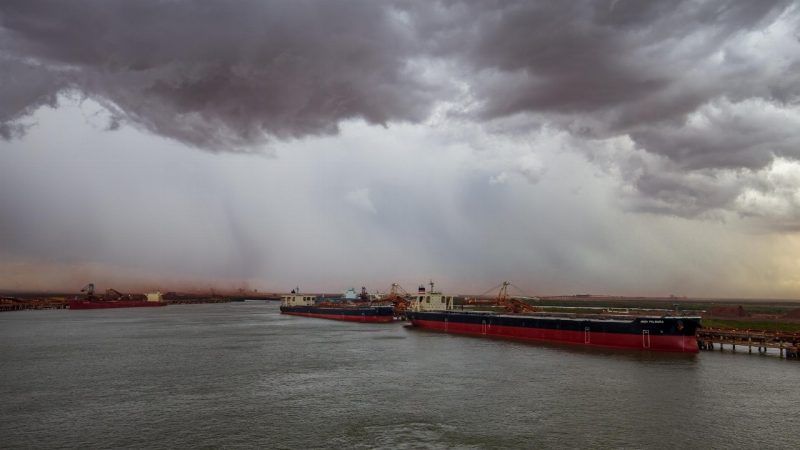- Iron ore has skyrocketed to a seven-year high as a hurricane warning threatens the world’s biggest iron ore export terminal
- WA’s Pilbara Ports Authority said it has started clearing large vessels out of Port Hedland in light of a severe weather warning
- The situation exacerbates uncertainty around iron ore as ongoing Chinese tariffs and trade bans threaten Australian iron ore sales
- Beijing and Canberra have had a souring relationship over 2020, with several heavy tariffs slapped on Australian exports
- While it’s unlikely either nation wants to touch iron ore, fears are mounting that the lucrative commodity could be next in line in trade tensions
- The uncertainty is sending the price of iron ore higher, and fast
Iron ore has skyrocketed to a seven-year high as a hurricane warning threatens the world’s biggest iron ore export terminal as much as souring Australia-China relations threaten iron ore sales.
The price of the metal, which is crucial to steelmaking, has had a stellar run over 2020, but the run was kicked into overdrive in December. Overnight, the metal hit well-over US$150 per tonne (around A$200 per tonne) — a price not seen since early 2013.
According to Fastmarkets MB, 62 per cent Iron fines — an international benchmark — were fetching US$156.58 a tonne (around A$207 a tonne) on Thursday.
The surging price is largely attributed to ongoing international tension between Beijing and Canberra.
However, the situation has been exacerbated by a hurricane warning from Western Australia’s Pilbara Ports Authority.
A tropical low off Australia’s northwest coast is forecast to bring gale-force winds and massive swell over the start of the weekend, prompting the ports authority to clear large vessels out of Port Hedland, which is the world’s largest iron ore export hub.
“Pilbara Ports Authority has commenced clearing the port and anchorages of the Port of Port Hedland of all large vessels,” the port authority said in a statement.
Port Hedland is used for iron ore exports by some of the world’s biggest miners, including BHP, Fortescue Metals, and Hancock Prospecting.
China-Australia fears
The relationship between Canberra and Beijing has been slowly deteriorating over 2020 as Australia continues to support the United States — which has been vehemently anti-China over recent years.
On top of this, Australia has denounced China’s Hong Kong sedition laws and joined the U.S. and the U.K. in rejecting China’s bold territorial claims in the South China Sea.
China has responded by slapping heavy tariffs on Australian products including barley, beef, wine, and more.
However, Australia’s iron-ore-rich soil gives the Australia-China scuffle an interesting dynamic.
China is, by some distance, the world’s largest importer of iron ore, accounting for almost 70 per cent of all global iron ore imports in 2019.
Yet, in recent months, Chinese demand for the metal has surged even higher as the country targets some major steel-intensive infrastructure upgrades to prop itself up in a post-COVID world.
What’s more, Australia supplies around 60 per cent of China’s iron ore, with much of the remainder coming from Brazil.
With such strong iron ore demand from China, the metal is by far Australia’s most profitable export.
This means despite the argy-bargy between the two nations, they still need each other. Particularly in their efforts to recover from the coronavirus pandemic, it seems at this point in time, neither Australia nor China wants to touch their delicate iron ore relationship.
Yet, with the threat of more heavy-handed tariffs on the way from China, two types of fears are beginning to mount.
On the one hand, commodity investors are wondering if and when China will begin to slap tariffs on iron ore.
On the other hand, there’s a chance Australia might begin to limit its own iron ore supply to China to hit back against the other tariffs.
In either scenario, Australia’s biggest commodity is likely to be dealt a nasty blow.
While neither side has threatened iron ore yet, the uncertainty is sending the price of iron ore higher, and fast.
Time will tell how long the bull market for iron ore will last.

